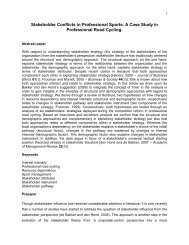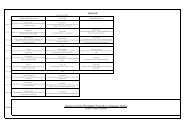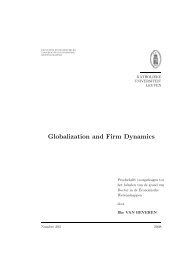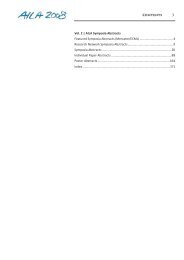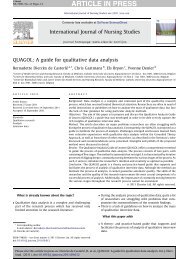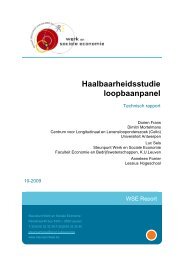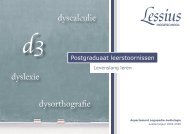The role of implicit attitudes towards food and ... - ResearchGate
The role of implicit attitudes towards food and ... - ResearchGate
The role of implicit attitudes towards food and ... - ResearchGate
Create successful ePaper yourself
Turn your PDF publications into a flip-book with our unique Google optimized e-Paper software.
Table 1<br />
Mean <strong>and</strong> st<strong>and</strong>ardized (SD) reaction times (RT) <strong>and</strong> percentage <strong>of</strong> errors (PE) on physical activity (PA) <strong>and</strong> <strong>food</strong> trials as a function <strong>of</strong> word category<br />
<strong>and</strong> extrinsic response valence, at baseline (T1), after six months (T2) <strong>and</strong> at a one year follow up (T3)<br />
T1 T2 T3<br />
RT PE RT PE RT PE<br />
M SD M SD M SD M SD M SD M SD<br />
Physical activity (PA)<br />
Sedentary+pos 861 229 7.89 8.09 716 127 6.14 6.11 638 110 10.09 10.96<br />
Sedentary+neg 855 213 7.39 7.29 714 106 7.89 8.09 688 120 8.33 11.79<br />
Moderate intense PA+pos 880 272 7.02 8.46 743 224 8.77 15.33 706 135 10.09 16.80<br />
Moderate intense PA+neg 902 263 10.53 9.56 742 155 8.77 8.99 658 148 7.46 12.39<br />
High intense PA+pos 814 207 8.77 8.55 746 217 12.72 14.27 679 167 7.89 8.99<br />
High intense PA+neg<br />
Food<br />
833 179 6.58 8.60 736 160 7.46 13.86 676 134 7.46 16.87<br />
Unhealthy <strong>food</strong>+positive 843 255 8.96 8.37 737 172 9.65 7.49 685 105 8.33 8.33<br />
Unhealthy <strong>food</strong>+negative 893 277 7.67 9.35 717 178 8.77 8.20 686 86 8.11 9.57<br />
Healthy <strong>food</strong>+positive 841 261 7.67 8.85 707 168 9.65 9.11 687 150 7.02 7.49<br />
Healthy <strong>food</strong>+negative 898 277 9.91 8.00 734 173 9.43 6.49 717 97 8.55 11.49<br />
self-reported <strong>attitudes</strong> <strong>towards</strong> <strong>food</strong>, showed a significant effect, F(1, 18)=4.47, pb.05. A post hoc paired t-test<br />
revealed that the participants were more positive <strong>towards</strong> healthy <strong>food</strong> than <strong>towards</strong> unhealthy <strong>food</strong>, t(18)=2.12,<br />
pb.05. Implicit associations are presented in Table 1; self-reported <strong>attitudes</strong> are described in Table 2.<br />
Remarkably, the same Repeated Measures ANOVAs with the dropout participants vs. the remaining group included as<br />
between variable, revealed a significant main effect <strong>of</strong> group on the PA EAST, F(1, 36)=5.27, pb.05, <strong>and</strong> on the <strong>food</strong><br />
EAST, F(1, 36)=6.25, pb.05, showing that the dropout group in general reacted faster than the remaining group (PA task<br />
respectively M=783 ms, SD=44 ms <strong>and</strong> M=843 ms, SD=51 ms; <strong>food</strong> task respectively <strong>and</strong> M=790 ms, SD=37 ms <strong>and</strong><br />
M=831 ms, SD=44 ms), possibly due to the mean older age <strong>of</strong> the drop out group. Further, both groups did not differ on<br />
the self-report <strong>attitudes</strong> <strong>towards</strong> PA, all Fsb1, however, an intriguing interaction effect was found between both groups<br />
<strong>and</strong> their self-reported <strong>attitudes</strong> <strong>towards</strong> <strong>food</strong>, F(1, 36)=4.87, pb.05, indicating that at baseline the dropout group was<br />
more positive <strong>towards</strong> unhealthy <strong>food</strong> <strong>and</strong> less positive <strong>towards</strong> healthy <strong>food</strong>, than the remaining group.<br />
3.2. Mean effect <strong>of</strong> the treatment on ABMI<br />
M. Craeynest et al. / Eating Behaviors 9 (2008) 41–51<br />
<strong>The</strong> mean total treatment time <strong>of</strong> the participants was almost eight months (M=7.89, SD=2.05). A Repeated<br />
Measures ANOVA with one three-level within factor (T1 vs. T2 vs. T3), showed a significant effect <strong>of</strong> time on ABMI,<br />
F(2, 17)=98.98, pb.001 (respectively T1: M=163.86, SD=14.97; T2: M=127.46, SD= 12.15; T3: M=130.21,<br />
SD= 16.43). Post hoc paired sample t-tests showed that the ABMI at baseline differed significantly from the ABMI at<br />
the end <strong>of</strong> the treatment, t(18) =13.50, pb.001, whereas the ABMI at the end <strong>of</strong> the treatment differed not from the<br />
ABMI at follow up, t(18)=1.07, ns. This indicated that the group <strong>of</strong> participants included in the present study became<br />
less overweight during the treatment, <strong>and</strong> that this decrease in overweight was maintained at follow up.<br />
Table 2<br />
Mean <strong>and</strong> st<strong>and</strong>ardized (SD) self-reported <strong>attitudes</strong> <strong>towards</strong> different kinds <strong>of</strong> physical activity <strong>and</strong> <strong>food</strong>, evaluated on a scale ranging from −3to+3,<br />
at baseline (T1), after six months (T2) <strong>and</strong> at a one year follow up (T3)<br />
T1 T2 T3<br />
M SD M SD M SD<br />
Physical activity (PA)<br />
Sedentary activities 1.34 0.99 1.70 0.97 2.00 0.54<br />
Moderate intense PA 2.04 1.06 2.07 1.01 2.16 0.80<br />
High intense PA<br />
Food<br />
1.02 1.09 1.67 1.02 1.88 0.80<br />
Unhealthy <strong>food</strong> 0.96 1.86 0.72 1.82 0.69 1.20<br />
Healthy <strong>food</strong> 2.07 0.80 1.89 0.97 1.91 1.24<br />
45




